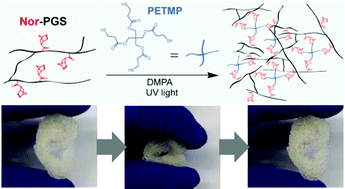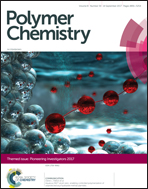Norbornene-modified poly(glycerol sebacate) as a photocurable and biodegradable elastomer†
Abstract
Poly(glycerol sebacate) (PGS) is a biodegradable elastomer that has emerged as a promising material in biomedical applications; however, the traditional thermal crosslinking of PGS limits its processing in the fabrication of three-dimensional (3D) scaffolds. Here, we designed a new photocurable PGS that uses thiol–ene click chemistry to control PGS crosslinking. Specifically, norbornene-functionalized PGS (Nor-PGS) macromers were crosslinked by varied amounts of a 4-arm thiolated crosslinker to program properties such as mechanics and degradation. The Nor-PGS crosslinked rapidly (<1 min to plateau modulus) under ultraviolet light and the storage modulus was dependent on the crosslinker amount, with a maximum storage modulus observed with an equimolar norbornene/thiol ratio. Tensile properties of Nor-PGS were also altered by the crosslinker concentration, with a simultaneous increase in elastic modulus and failure stress and decrease in elongation (ranging from ∼170–240%) with higher crosslinker concentrations. In turn, the degradation of Nor-PGS was faster with lower crosslinker concentrations. To illustrate the processing of Nor-PGS, porous scaffolds with a range of sizes and shapes were fabricated using extrusion-based 3D printing, where the viscous macromer was extruded and crosslinked with continuous ultraviolet light exposure. Printed scaffolds supported the culture and proliferation of fibroblasts. These results indicate that crosslinked Nor-PGS is a promising functional elastomer for the fabrication of property-controllable scaffolds for biomedical applications.

- This article is part of the themed collection: Pioneering Investigators


 Please wait while we load your content...
Please wait while we load your content...